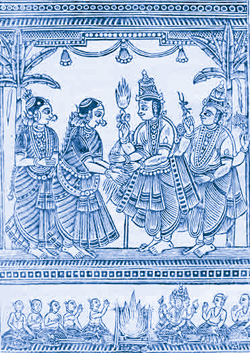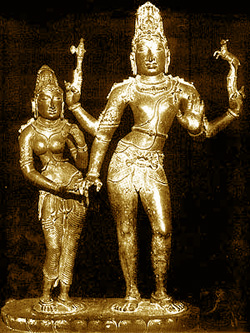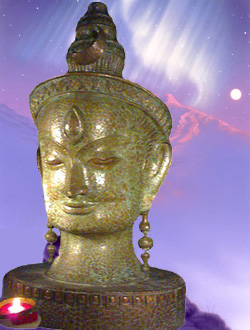SHIVA-KALYANASUNDARA
SHIVA in the hypostasis of protector and sustainer of those hearts that are full of a great love
by profesor yoga Gregorian Bivolaru

The hypostasis SHIVA-KALYANASUNDARA is one of the most fascinating and charming beneficial hypostases of SHIVA. It is the hypostasis of SHIVA in which he manifests himself full of a divine beauty taking a SHAKIT as a wife, the one who was born as Parvati, and who was the daughter of the Himalaya mountain. This hypostasis of SHIVA is based on the following mythical story: “Parvati was the beautiful young daughter of the Himalaya mountain and his wife, MENA. As a young virgin, Parvati was not at all concerned about playing with the other children. From when she was little she was frequently inclined to profound meditation on the supreme, SHIVA, retreating herself periodically alone in the mountains.
She wanted with a great ardour to be the lover and spiritual bride of SHIVA. For this she started to make a retreat to meditate non-stop in the snowy mountains of the Himalayas. Her parents hesitated to grant her permission to do this, but the decisive young girl, who was also incomparably beautiful, sensual and full of great vitality, finally persuaded her parents. Parvati went then to an ashram in the mountains, doing there all mediations and an entire tapas consecrated to SHIVA. SHIVA was charmed with the firmness and extraordinary aspiration of this young girl came personally to the place where she was meditating to test her fervent devotion.
Taking the appearance of a old aspirant, he came close to the Parvati. The young Parvati granted him the all respect due to an old man who was devoted to the worship of her beloved SHIVA. Without waiting, the old man told the girl that there was no point wasting her youth and energy by making all there severe austerities and that it would be far better that she, being so young and so sensual, was married. Furthermore, the old man in question suggested that it would be the most appropriate to marry him, who was a great worshipper of SHIVA. What is the point, he added, to desire that one, Shiva, who dances through cemeteries and who wears bones and skulls as trinkets.
Parvati, who initially did not realise that under the guise of this old man was really her lover SHIVA, became very angry when she heard these words. Shocked, she told the old man that until now she had given him her respect only because it seemed that he was a sincere worshipper of SHIVA. But behold, he wants her to deviate from her spiritual practice, so from that moment she no longer wants to hear from his mouth any kind of blasphemy relating to SHIVA. With a firm and very authoritative voice she told the old man to immediately leave that place.
Delighted by unshakeable decisiveness which the young and beautiful Parvati had in adoring Him, SHIVA revealed himself from under the guise which she already knew him. Parvati was pleasantly surprised by the unexpected appearance and asked forgiveness because she did not recognize immediately SHIVA in the guise of an old man. SHIVA told her that he accepted her previous rebuke as a sincere and very deep calling that expresses the boundless longing of young and beautiful girls to embrace him full of love. Did this rebuke not really come from a deep love of SHIVA? SHIVA decided to offer the young and very beautiful Parvati the priceless gift which she fervently desired, which was to become her beloved.
The royal family of the girl from Himalaya was delighted to learn that their beautiful and beloved daughter was to be married. The entire region was decorated very beautifully and began to prepare for the celestial ceremony, caught by a charming divine brightness. Parvati was decorated also and she glowed with an unparalleled happiness in the moment of her ecstatic union with SHIVA. SHIVA was expected. He came to the wedding ceremony riding on a bull, with skulls and bones adorning his body as trinkets and having wrapped around his waist only a tiger skin. As a retinue of the wedding SHIVA came with several cohorts of ghostly spirits, BUTAGANA, the dead. Seeing this horror, the mother of young bride fainted at once, being very shocked at the thought that groom of her girl, the one full of sweetness and sensuality, more beautiful than all flowers on the ground, had an appearance so terrifying.
 But arriving at the place of wedding, the divine groom, SHIVA, transformed at once his appearance to that of the ascetic and in the guise to all of those present with a face of an unparalleled beauty and brightness, sparkling and full of priceless adornments and in addition having a splendid garments. When you girl’s mother, MENA, and recovered from fainting, she was this time delighted by the appearance of the groom of her girl and now was very happy, seeing that he is the most suited for her beloved daughter, and she also realised in the end, that the mysterious, divine game of SHIVA has no limits. In this case, the mother of the young Parvati, had not seen initially anything other than the external aspect, appearance of SHIVA. But, in fact no other being, except Parvati, could see before the greatness and splendour of the divine groom, SHIVA, and the glory emanating always from his divine being. The enchanting SHIVA, in his wedding robes, married the daughter of the mountains, Parvati, and since then, his most beautiful form, which was seen by people on his divine wedding day, has been called KALYANASUNDARA.
But arriving at the place of wedding, the divine groom, SHIVA, transformed at once his appearance to that of the ascetic and in the guise to all of those present with a face of an unparalleled beauty and brightness, sparkling and full of priceless adornments and in addition having a splendid garments. When you girl’s mother, MENA, and recovered from fainting, she was this time delighted by the appearance of the groom of her girl and now was very happy, seeing that he is the most suited for her beloved daughter, and she also realised in the end, that the mysterious, divine game of SHIVA has no limits. In this case, the mother of the young Parvati, had not seen initially anything other than the external aspect, appearance of SHIVA. But, in fact no other being, except Parvati, could see before the greatness and splendour of the divine groom, SHIVA, and the glory emanating always from his divine being. The enchanting SHIVA, in his wedding robes, married the daughter of the mountains, Parvati, and since then, his most beautiful form, which was seen by people on his divine wedding day, has been called KALYANASUNDARA.
Remember here that this hypostasis is extremely important for all women who perform the secret ritual of engagement with SHIVA. This hypostasis of SHIVA is also known as VIVAHIKAMURTI. This hypostasis represents SHIVA as the divine groom together with Parvati, who is his divine bride. According to the work of SILPA RATNA, Parvati is described in this representation as having a state of profound self-absorption and totally independent of the surrounding conditions, ZVAIAMVARA. Legendary fragments that are described in some PURANAs, in the epic poem RAMAYANA or the well-known epic poem KUMARASHAMBAVA, offers also some essential information regarding the existence of this representation in particular about the wedding ceremony.
In these fragments it is said among other things that the divine ceremony was celebrated even by Brahma, the creator of the universe, as a priest officiating at the ceremony, while Vishnu, Parvati’s brother, was the godfather of the bride. The spiritual wedding took place in the presence of all the inhabitants of the celestial realms In all representations of this hypostasis, SHIVA and Parvati are always in the centre of attention. On the other hand, sculptures of ELEPHANTA and ELORA present in a narrative style, in relief and they describe in detail the much talked about marriage. Most iconographic treaties recommend that the representation of SHIVA KALYANASUNDARA to be surrounded by subtle guardian beings of the directions of space, DIKALPA, by gods, DEVAS, together with their wives, SHAKTI, and also the demigods and spiritually accomplished being, SIDDHAs, and the wise men, such as NARADA, a multitude of beings from the seven mysterious realms of existence, MATRIKA.
All those present are depicted with facial expression full of happiness, enjoying and marvelling at this spiritual grandiose event. Each and every one of them holding their hands together in a sign of dedication and devotion. For sculptors, the approach to this representation of the scene of the marriage of SHIVA with Parvati, must be carried out with such great craftsmanship that it may inspire in the one who views it a profound state of both awe and delight at the divine beauty of KALYANASUNDARA SHIVA and his beloved Parvati.
Most often the iconic representation of the hypostases of SHIVA, on the stone columns of temples or on narrow portions in bronze, contain alongside the divine bridegroom, SHIVA, and divine bride, Parvati also Vishnu and Lakshmi, together with Brahma in the role of the one officiating at the holy marriage, PUROHITA. Sometimes, this representation only includes SHIVA, Parvati and Vishnu, in which case Parvati is in the middle, SHIVA on the left and Vishnu on the right side of the bride, slightly to the rear, all three standing facing the sunrise.
 According to most treaties such as SAKALA DIKARA, UTARA KAMIKA, PURVA KARANA and SILPA RATNA, in this hypostasis, SHIVA is represented as being an extraordinarily beautiful being, SUNDARA, in his early youth and with a face that is very bright, full of love bursting with a sublime, transfiguring eroticism, SRINGARA. He is adorned with many bright, multi-coloured jewels, and has an appearance which is full of goodwill. The colour of his skin is similar to the hue of red coral. He is standing with his left leg perfectly straight, while the right leg is slightly bent.
According to most treaties such as SAKALA DIKARA, UTARA KAMIKA, PURVA KARANA and SILPA RATNA, in this hypostasis, SHIVA is represented as being an extraordinarily beautiful being, SUNDARA, in his early youth and with a face that is very bright, full of love bursting with a sublime, transfiguring eroticism, SRINGARA. He is adorned with many bright, multi-coloured jewels, and has an appearance which is full of goodwill. The colour of his skin is similar to the hue of red coral. He is standing with his left leg perfectly straight, while the right leg is slightly bent.
In the work SAKALA DIKARA, the position of SHIVA’s body is described as being the one in which he plans to start to walk. He is represented in a posture or attitude of the triple bend, TRIBANGA, the position in which the line of the body presents three easy inflections which confers an unparalleled beauty. He has four arms, bearing the black antelope, KRISNA MRIGA in his left upper hand and the axe, PARASHU, in his right upper hand. His right hand is stretched outward to hold Parvati by her right hand, while his left hand at the front makes the secret gesture of blessing BARADA MUDRA. On his head SHIVA wears a high crown made from braided strands of hair on which is emblazoned the symbol the waxing moon. He has three eyes one of the three is AJNA CHAKRA. On his neck he wears a necklace, HARA, and on the hand a bracelet, KEIURA.
According to the work PURVA KARANA, the three snakes, BASUKI, TAKSHAKA and PUSHKARA, the symbols of his mysterious power, now fulfil the role of his jewels. Here’s how is the hypostasis SHIVA KALYANASUNDARA is described in one traditional Indian work: “Having his body the colour of bright red coral, INDURAM, with his third eye bright and full of happiness, his shoulders strong that resembles the four eras of the existence of macrocosm, the YUGAs, wearing a necklace and bracelets of unparalleled beauty, with multi-coloured clothes, gleaming in his wedding clothes, with a enchanting and beautiful body and face, he, SHIVA KALYANASUNDARA, holds the hand of his beloved Parvati in his divine hand, while in the others he holds a lotus, antelope, axe, and in his hair are caught the moon and heavenly GANGES.”
The secret work SAKALA DIKARA indicates that perseverant and frenetic worship of this hypostasis of SHIVA triggers in the aspirant an intense and unparalleled state of profound inner peace. The work SILPA RATNA adds that SHIVA KALYANASUNDARA is the only all-favourable hypostasis of all the hypostases of SHIVA. It is also very easily accessible everywhere, SARVAMANGALA. This hypostasis of SHIVA is in a close and deep connection with the extremely favourable moments that occurs cyclically two days before the period of full moon. Also it is the most favourable monthly cyclic moment of the manifestation of the deeply beneficial subtle influence of the great cosmic powers of beauty and of love divine, TRIPURA SUNDARI. At this time very favourable hypothesis that is SHIVA KALYANASUNDARA, SHIVA can be evoked in our being with the greatest ease and especially then he will manifest for those who call him with much love and faith as a divine protector of profound and lasting love.
yogaesoteric
29 March 2012


